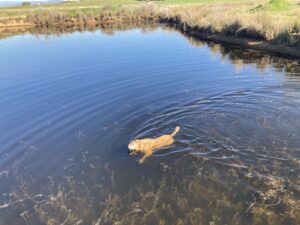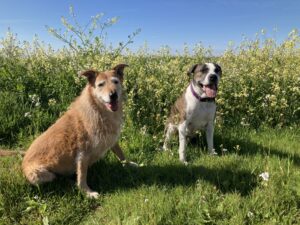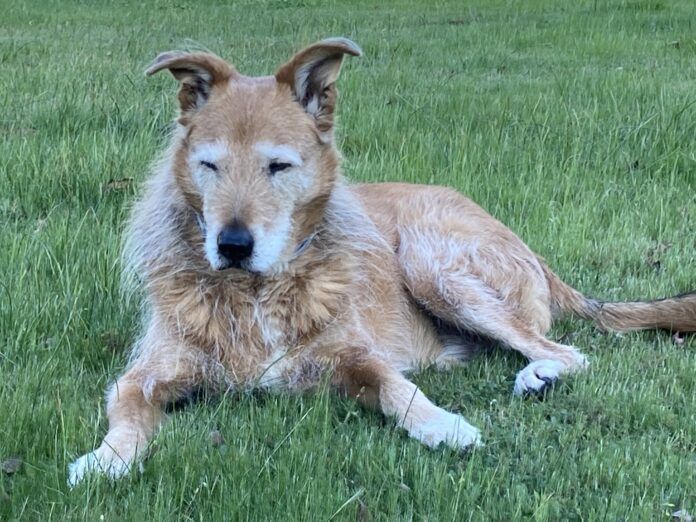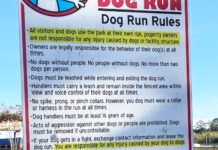A few weeks ago I shared that my 14-year-old mixed-breed, Otto, was showing signs of age-related dementia. He’s also showing more discomfort related to his osteoarthritis. The post struck a chord with more than a few readers, and many of you mentioned things that had worked for your own dogs in the past, or a dog you knew. The suggestions included:
- Crating at night
- Herbal remedies, including California Poppy, Passionflower, and Chamomile
- Selegiline (generic name of Anipryl; prescription medication)
- Lions Mane (mushroom-sourced supplement)
- Aromatherapy
- Adaptil collar
- CBD chews (supplement)
- NaturVet’s Emotional Support (supplement)
- acetyl l-carnitine and alpha lipoic acid (supplements)
- Cholodin (supplement)
- Clomicalm (prescription medication)
- MCT oil (supplement)
- Melatonin (supplement)
- Trazodone (prescription medication)
- Purina’s “Bright Minds” food
- A night light
- SAM-e (supplement)
I appreciate every single one of these suggestions, and am glad that dogs have been helped by these things. At the same time, the list highlighted the helplessness that any of us may experience at a time when our beloved dogs have a chronic or ambiguous health issue. How the heck does one decide? You can’t do it all; it’s not fair to turn your dog into a chemical science experiment. Plus, if you are using multiple treatments, and your dog’s condition improves, do you know which thing helped? Do you keep doing all the things?
Important note: Anything you do has to start with your veterinarian. Just randomly adding things without knowing what’s wrong (or, at least, what’s not wrong) is irresponsible. It would be awful to learn, after you’d been giving your dog all sorts of various supplements and remedies that he had undiagnosed and untreated cancer, for crying out loud. We’re many thousands of dollars into Otto’s medical surveillance, including frequent blood and urine tests, x-rays, and abdominal ultrasounds – he even had an MRI a few years back, when he had a (fortunately benign) mass removed from his liver – and thank goodness AGAIN that I’ve been investing in Otto’s health insurance for many years.

I’m assuming that your vet is included in the discussion of “What can I do for my dog?” and you’re still at a loss – and I mentioned this specific frustration to my own vet, while she was treating Otto with acupuncture. She mentioned a couple treatments that helped her own senior dog who had dementia in that dog’s last years of life. I asked her, as a general question, “When there are so many options, where does a dog owner start? How do you know what to do?”
She answered, as I would expect a veterinarian would, “Ask your vet!” And I agree! And yet, in this very specific case, I have been asking a vet, three of them, in fact. Including her! And we’ve tried a few things without any of them making an appreciable difference.
My personal tactic is to try something for a minimum of a month; I’ve tried a couple more things for two or even three months when I was told that it takes time to see an effect. But if I see no effect whatsoever – if Otto’s behavior and gait absolutely do not improve in any way that I can see, I stop that particular supplement or treatment and try something else (see “Amantadine: Now for Relief of Chronic Pain,” WDJ August 2022).
The one thing I know works for Otto’s osteoarthritis pain is a prescription nonsteroidal anti-inflammatory drug, Galliprant. I’ve also tried gabapentin and Trazodone, which both have been recommended for pain as well as the sleeplessness Otto often displays at night. I also tried a month’s worth of SAM-e. I’ve stuck with the gabapentin the longest, but honestly, I don’t think it’s doing anything. I’m currently weaning him off of it, without seeing any decline or difference at all.

I recently bought a CBD product to try on Otto (after researching an article on how to choose a CBD supplement and writing an article about this, which will appear in the April issue). At his next acupuncture appointment next week, I’m hoping to pick up selegiline to give that a try. We discussed it at our last appointment, and I’ve left a phone message for the vet mentioning that I want to try it next.
The hard fact is, we can’t fix everything our dogs are suffering from with a pill or treatment – but because we can fix or improve many things, and because we love them, we remain hopeful.
Also – and I’m as guilty as anyone of this – it’s often easier to hope you can fix everything that’s wrong with a pill or supplement than it is to simply slow down and spend more loving time with our senior friends – to do more hands-on massage, gentle grooming, extra nail trims, and just being present with them. Writing this has helped me realize I need to do of more just that, and a little less fretting about the next pill to try.







I have two elder GSD’s right now, and one active 10 month old GSD pup. Your article hits a heavy chord with me as so timely that I wonder if someone is looking over my shoulder. With one of my elders I moved on from the “trying to fix it” phase to love and comfort about a month ago, and am hoping she’ll let me know when she had her fill of life. The other elder, who is the older of the two, is failing as well, but not as quickly as my female. However, with his strong aversion to vet visits, I have moved him to the love and comfort category as well. While it is difficult to let go of the need to try everything, I find that my elders and I are bonding in a new way and enjoying the time we have left.
❤️
It is as hard to watch our advanced aged companions slip from us as it is to watch our parents’ decline over time. Having my last four pets all over eleven decline from osteoarthritis, cancers, and dementia, we must ask ourselves- are we helping provide them the quality of life they enjoy or are we just saving ourselves the guilt of timely euthanasia when all options do not improve their quality of life. Many disagree pans truly believe that any life is a quality life – but at what cost to the animal too immobile and soiling itself in its bed, the dog that must be helped outside and then sits as it’s too hard to walk, the dog who can no longer hear and sleeps more than it is awake?
I am still beating myself up for not “trying harder” to save my 14 yr old shepherd girl although I knew deep down as did my vet that trying this drug and that drug and this ointment; thousands of dollars later, she was just getting worse. Over the course of the next two months as a freezing cold snow packed winter took hold, I watched her decline as anal gland cancer took over her body causing her to lose weight and become weaker each day. Osteoarthritis ravaged her hind legs making her unable to go up or down stairs on her own to pee in her chosen spot at the end of the yard. I had to be with her always to prevent falls. Due to the cancer, she developed fecal incontinence which was difficult to deal with but if having her here again meant washing her bedding and my floors at 2 am then I would gladly have made the trade to have more time with her. On her final day there was a puddle of bright red blood next to her bed that had dripped from her wound overnite yet she was still trying to clean up after herself. Doing wound care twice a day was painful for both her and myself and that morning I knew what I had to do. As difficult as saying goodbye would be, it was the right decision for both of us. By now, she had lost interest in food and drink and just wanted to sleep or lie down. I watched her fade over a few days-it was quick and difficult to come to terms with. Was I really going to have to say so long to my constant companion, protector, best friend and confidante? I really couldn’t picture my life without her.
It’s been 2 months since my beloved ‘Shatzie’ left me and the house is just too quiet without her. I know it’s too soon to think about another dog-she was such a huge part of my life. I still have alot of guilt that I didn’t try hard enough but deep down we both know I did everything I could. Just before she took her last breath, her eyes told me that I had made the right decision and she was grateful that I was letting her go. I love you and miss you my girl.
I am so sorry for your loss. I’m sure Shatzie had the best life any dog could want and she stayed as long as she did because she loved you.
It is never too soon and is a tribute to our dogs that they instill in us a desire to love another dog even though we know how briefly that will be. After Caesar died I lasted two months before I started looking. After Ramses died I didn’t last two weeks. He died on Thanksgiving night and I brought Diana home December 22. And while I wasn’t looking for a second dog, Diana’s birthday found me Freyja who was red-carded so we drove three hours to pick her up and save her from death row. She has no idea. She just knows she has a wonderful life and is never alone and will never go back to a shelter again.
Dogs give us so many gifts but the one they give most is their place to another dog that needs love and a home. It is never too soon. It is a tribute to Shatzie, not a betrayal.
After respected, tried and true medical resources, perhaps care with comfort, loving communication w/our ‘elders’ is truly just what’s needed. We all-people and our dogs- need to share our feelings, physical and emotional. Love is the best!🐾🐾❤️
I would love to find a supplement that works but so far struck out completely. I seems anything that isn’t harmful also doesn’t seem to be beneficial. One month should be enough to test a product especially if you watch your dog suffer. Galliprant is what I decided on and would be my go to now bypassing the supplements. We do give Dasuquin as a preventive but I don’t believe it would make a difference once a dog exhibits orthopedic problems. Gabepentin has not been useful for us. Rimadyl does work but for long time use I try to avoid it and go for the Galliparant instead. WE have a 14 and a 12 year old now so anything can happen.
We used the Purina Bright Mind for at least 2 years on our oldsters in the past but really didn’t see any benefit. I feel the frustration trying to find the best solution for our oldsters.
This journey you are sounds exactly like where I am at. Two seniors, 11 and 14, with different issues. The 14 yr. Old is more stable than the 11 yr. Old and tomorrow I am traveling to a vet school rehab clinic to try to find something that will help my boy. A recent move has left us with new vets and I am just not satisfied with the “just arthritis” nod of the head. So many supplements and meds (all vet recommended at some point) but my boy is not remaining stable. Even with weekly acupuncture, chiro and laser treatments he continues to experience more rear end weakness. This is so difficult for a dog who used to compete and participate in dog sports. Not ready to stop trying everything I can and frightened that this is something more serious.
U did hydro-therapy fir both my german Shepard’s & it worked wonders fir 3 & 4 years. Eventually, his hind legs will stop working.
Then, I used Help-Me-Up harness until it was time to say goid bye.
I have a senior dog who has been plagued by osteoarthritis for years. He is on so many joint supplements, like you, I wonder what works and what doesn’t. Yes, the walks are shorter, and yes, the run and play ball times aren’t as long, but he still enjoys them.
I wish there were geriatricians for dogs as there are for us humans.
I have six layers of egg crate foam stacked as his bed which he uses; and the senior cat does too! Gabapentin, DGP, Duralactin, Vetriscience joint chews, need I go on.
Oh, I forgot, cold laser treatments and hydrotherapy as well.
He loves the cold weather, so the walks are like the ones we used to take. But when we had two days of 60+ weather, he struggled to walk half as far. I fear this coming summer may be way too much for him to handle.
It is so frustrating when people ask his age, and I proudly say 12; then the look of pity , and the awwww. I am so grateful he is with me and intellectually understand his time is finite. Emotionally, well that’s another story.
We all do the best we can for these beautiful creatures and must acknowledge when it is time for their energy to pass on to another plane.
We went through a similar situation with our 14 1/2 year old greyhound. Her pain and instability in her hips and back legs had progressed to the point of essentially keeping her completely sedated to be comfortable. Gabapentin helped a lot but only to keep her asleep. Walking her to pee her back legs would just give out. She had stopped eating most food other than milk bones soaked in chicken broth to soften them up so she could chew them.
We decided with our vet that it was time. It’s been almost a year and I’m still not over it and probably never will be. She was my soul mate and I can never go through this again.
My dog, a 14.5 year old male/neutered Cairn Terrier. “Fritzi” is in the same boat as Otto is. I have tried Gabapentin (terrible for him…too wobbly, too tired – even with 1/2 the recommended dose). He had an ACL tear 2 years ago and TPLO surgery by a specialist (who did an amazing job, but aftercare was very trying…keeping a Terrier confined for many weeks is a challenge!). This surgery likely didn’t help the arthritis onset…which I was informed about prior to his surgery at age 13. He is now on Galliprant which seems to help. I give him Fishoil (Vet prescribed), home made tumeric paste (to make me feel better, I think), he gets Dasuquin, prescription strength. He now developed a front leg elbow dysplasia – likely due to wear and tear. No more surgeries for him. He is happy, wants to go on walks (two times 20 min per day, every day…) he also has chronic pancreatitis – we have him on low fat prescription food. If I add up everything, including my pet insurance which is now $120/month….my pooch runs easily between 300-350 dollars a month, without the vet bills, just medication, supplements and insurance. But he is my friend, buddy, my husbands co-pilot in his home office and a joy to have around. I feel helpless when he hurts on cold days….but i remember my Grandmother in the late 60’s when she had Arthritis, she said…”its part of getting old” – you just have to live with it!
My Great Pyrenees had wonderful results with Adequan. It took some finagling to find out that for her, she needed a maintenance injection every 6 weeks after the initial titration. Within a day after that injection, she would move freely up a flight of steps to reach the 2nd floor of the house.Being a Pyr, she wouldn’t take advantage of the heated bed liner but by senior pug certainly was helped by that as well.
The physician’s insert for Adequan reports how every single one of the dog test subjects had micro lesions on the liver after the initial 6 week treatment. The Adequan worked wonders for awhile at the recommended label dose, but then I had to provide a booster shot for her every 6 weeks for about a year until the booster shots stopped working. One of the technicians at the Adequan lab told me that once the joint cartilage was worn down, Adequan could no longer repair the joint cartilage or reverse the disease process, and the effect she was experiencing toward the end of this course of treatment was the “plumping up” of the synovial fluid and reduction in inflammation. For the first year it was amazing how well the shots worked but the treatment wasn’t started early enough to reverse the disease process or to do much in the repair of joint cartilage; however, a vet told me that Adequan was not without its dangers in regard to liver damage and that the Adequan could have hastened her demise. I loved to watch her joyfully running in the forest after a shot.
Galliprant worked great for Buddy. As did Senilife for the dementia.
I love WDJ and your “from the heart” articles. I have an 11 year old boxer girl, who is fortunately doing well. We have been on Galliprant for 2-3 years and it is a really good drug with less harm to other organs. I never liked gabapentin, made too drowsy. I give a joint supplement, a probiotic, and a CBD chew last thing at night. She has had an occasional bout of “something” in middle of night a few times — very gassy stomach and distress, and I am terrified of bloat, so recently did fecal and ultrasound. Yes, thank goodness for pet insurance. No conclusions on those tests, so may try a diet change and in the meanwhile giving omeprazole an hour before evening meal. We do love them so and want to do all we can to keep them happy and well.
For acid reflux try a product called “gut guard” it has licorice, aloe, etc. Great product for acid reflux. My 100lb dog started at 1 tsp with dinner daily and now just every other day. No reflux at all. Use in place of omeprazole.
My vet put my Ramses on Omeprezole for acid reflux, the same dosage I take for my acid reflux.
My 13 year old pup Henry (passed Dec. 2020) had such bad arthritis that my vet sent the xrays around to see if other vets thought he had some sort of autoimmune problem. The only thing that helped him was Adequan. We gave him shots every 2-3 weeks. Ultimately, I think not much alleviated his pain–he was also taking Dasequin, a tumeric supplement, etc. I tried CBD oil but it didn’t seem to have any impact at all. The Adequan did restore a bit of his mobility and seemed to prevent further degeneration of his knee joints (where the problem was).
I just wanted to make you and others aware of Copaiba, an essential oil. Our 13 year old mini aussie went into a deep depression after losing his best canine buddy. Twice. He gained much too much weight in spite of our best efforts, didn’t want to move. He already had a malformed shoulder and resulting arthritis. He’s been on prescribed supplements for a long time. Then I consulted with Dr. Janet Rourke, “the essential oil vet”. Copaiba seemed to be the most helpful of her recommendations for pain. We had also gotten a puppy, primarily for him. Now he still has arthritis but he’s willing to play, to run a little bit, loves his walks again. He’s lost nearly 5 lbs and is now a healthy weight. I am so grateful! He is our third seriously arthritic dog. We’ve tried lots of things. I won’t attempt to delve into the science of copaiba; I would leave out too much. I just encourage others to check into it.
As an animal massage therapist who co-owns a hydrotherapy pool for dogs, this is something we discuss with our clients quite regularly. For those who have the option, I will say that swimming or underwater treadmill can be hugely beneficial to arthritic dogs; the support of the water while getting exercise and moving stiff and sore joints and soft tissues can be really helpful. As for supplements and medications, it can be really difficult (and expensive), because there is no one-size fits all answer. Yes, talk to your vet! I will say, that with my own aging dogs and many client dogs, I have seen a huge benefit with the combination of hydrotherapy, acupuncture and cold laser treatments.
I am sitting here crying my eyes out reading this article and the comments. I have a little Yorkie, she is going to be 11 soon. She is my first dog and the love of my life and I CANNOT imagine life without her. She has luxating patellas in both back legs and medial shoulder instability in both front legs. She gets PT and cold laser treatments as well as swimming. I rehabbed her for 7 months after the front leg injury. She got better WITHOUT surgery. She is small but mighty!! I am now dealing with the fact that she has developed Irritable bowel disease and she is getting sick at least once a week, throwing up and bloody diarrhea. With the help of my beloved Vet, I have tried everything from prescription food to various antibiotics that used to work, but now don’t. I took her to an internal medicine doctor who agreed with my beloved Vet that she needs to be on steroids to calm the inflammation down. I STILL haven’t put her on the steroids, despite filling the compounded prescription. I just cannot bring myself to do it because of all the nasty side affects. I just keep hoping she will get better like she always did before.
I have decided that I am going to wait until April (I am 65 years old and recovering from a total hip replacement ) and then I will be able to take her for walks again and maybe the fresh air and sunshine will help alleviate any side affects from the steroids.
If anyone here has experience with putting a Yorkie on steroids, would you kindly comment??
Not a Yorkie, but a dog with IBD, seizures, arthritis, numerous liver infections, gallbladder removal, cancer surgery, and a new heart murmur. He’s been on very low dose prednisone for years. Every time we try to wean him off, something else goes seriously wrong. For him, the adverse effects of prednisone are still better than the effects of eliminating it entirely. He’s closely monitored by his regular vet, and internal medicine specialist, and a neurologist.
Dog Gone Pain! How can you forget Dog Gone Pain, on which you published an article a number of years ago. I had a Great Dane/Lab mix with severe arthritis who couldn’t tolerate any NSAID, and we had tried them all. I read your article and tried Dog Gone Pain, and it gave my dog her life back. A dramatic difference and she experienced no side effects.
A breeder suggested Move Free. I get it from Costco. My 11 year old GSD has hip dysplasia and arthritis. The dosage for a human is 2 tabs….I give 1 tab nightly. I grind it to a powder and put it in her food. I have noticed a significant difference.
Nancy, hopefully your Otto will do well on selegiline (Anipryl). Several dogs ago, perhaps 10-15 years ago, our beloved Sheba, a shepherd/husky mix, had dementia and the drug worked wonders for her. She was restored back to normal mentally. However, she was ultimately done in by a brain stem tumor. She seizured twice in one day and was unable to even raise up the upper half of her body from lying down. We had no choice but to let her go as she was unable to even move around on her own. We saw in her eyes that she asked us to release her from her misery. With great regret, this is what we did….
In particular your last paragraph Nancy. Thank you Thank you Thank you.
Please use caution when suggesting licorice, ir raise blood pressure, helps adrenal glands. Coconut can be absolutely deadly for the Shetland Sheepdogs . The gets what is called a Mucocele, is causes the Gallbladder to rupture. It is horrible to died from. Also, all Shelties and other close breeds can have MDR1. It can be deadly they is a list of items if they touch it they will die.
Thank you all for your time. Just be careful what you give and or recommend to others for their Dogs. We love them unconditionally, and they trust us forever and always.
Please excuse my mistakes I have arthritis.
Went thru this with my 13 year old lab recently. Joint issues and back end weakness. We did chiro, acupuncture, gabapentin, and rimadyl as needed. My goal for her was to keep her walking, which is what she enjoyed most in life. Her peripheral eyesight was gone and she probably had cataracts but her nose still worked great! She was walking 45-60 minutes a day with no limping. Had her first seizure on Saturday, recovered quickly, fine on Sunday, woke up on Monday morning to another seizure, but this time she had a stroke and couldn’t walk. She went into a panic every time she tried. Putting her down broke my heart but it was really the kindest thing I could for her.
Ramses was on Galliprant which helped his back as he had degenerating discs and was on Gabapentin. My parent’s dog was on Trazadone. They helped them but I think it depends on what the problem is. Candy had arthritis and the Trazadone helped her. Ramses not only had back problems but it turned out he had bone cancer. Eventually when the Galliprant and Gabapentin weren’t enough he was weaned off of them and put on Trazadone and Prednisone. He wasn’t on them for long but for the time he was, they did help him to move. He had been sleeping outside but starting to come in and sleep in the bed with me again, although I did have to lift him up and then in the morning back down again.
What works depends on what is wrong and sometimes it is just trial and error to find the right mix and dosage. I tried CBD oil as well, the real stuff, not the hemp stuff. Ramses ended up at two drops as three would make him a bit loopy and one had no effect at all. I wish they had done the x-rays when I had asked as I would have put him on pain killers much sooner. By the time I noticed it I’m sure he was in agony and not able to hide it any longer.
You wrote that article on CBD supplements would be coming in April issue…… I couldn’t find it in April or May. Will it be coming soon?